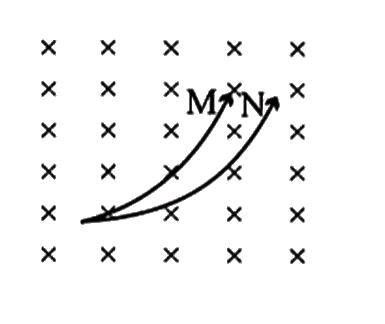Which of the following particle will have minimum frequency of revolution when projected with the same velocity perpendicular to a magnetic field?
Electron
Proton
The correct Answer is:A
Step by step video & image solution for Which of the following particle will have minimum frequency of revolution when projected with the same velocity perpendicular to a magnetic field? by Physics experts to help you in doubts & scoring excellent marks in Class 12 exams.
Updated on:21/07/2023Topper's Solved these Questions
- MOVING CHARGES AND MAGNETISMBOOK - AAKASH INSTITUTE ENGLISHCHAPTER - MOVING CHARGES AND MAGNETISMEXERCISE - Assignment (Section B) Objective Type Questions (One option is correct)
35 Videos
- MOVING CHARGES AND MAGNETISMBOOK - AAKASH INSTITUTE ENGLISHCHAPTER - MOVING CHARGES AND MAGNETISMEXERCISE - Assignment Section C (Objective Type Questions (More than one option are correct)
14 Videos
- MOVING CHARGES AND MAGNETISMBOOK - AAKASH INSTITUTE ENGLISHCHAPTER - MOVING CHARGES AND MAGNETISMEXERCISE - Try Yourself
27 Videos
- MOVING CHARGE AND MAGNESIUMBOOK - AAKASH INSTITUTE ENGLISHCHAPTER - MOVING CHARGE AND MAGNESIUMEXERCISE - SECTION D
16 Videos
- NUCLEIBOOK - AAKASH INSTITUTE ENGLISHCHAPTER - NUCLEIEXERCISE - ASSIGNMENT (SECTION-D)
10 Videos
Similar Questions
Which of the follwing particles will have minimum frequency of revolution when projected with the same velocity perpendicular to a magnetic field?
View SolutionWhich of the follwing particles will have minimum frequency of revolution when projected with the same velocity perpendicular to a magnetic field?
View SolutionThe path of a charged particle in a uniform magnetic field depends on the angle θ between velocity vector and magnetic field, When θis0∘or180∘,Fm=0 hence path of a charged particle will be linear.
When θ=90∘, the magnetic force is perpendicular to velocity at every instant. Hence path is a circle of radius r=mvqB.
The time period for circular path will be T=2πmqB
When θ is other than 0∘,180∘and90∘, velocity can be resolved into two components, one along →B and perpendicular to B.
v|/|=cosθ
v^=vsinθ
The v⊥ component gives circular path and v|/| givestraingt line path. The resultant path is a helical path. The radius of helical path
r=mvsinθqB
ich of helix is defined as P=v|/|T
P=(2imvcosθ)
p=2πmvcosθqB
Which particle will have minimum frequency of revolution when projected with the same velocity perpendicular to a magnetic field.
View SolutionWhich of the following particles will describe the smallest circle when projected with the same velocity perpendicular to a magnetic field?
View SolutionWhich of the following particles will describe wll experience maximum magnetic force(magnitude) when projected with the same velocity perpendicular to a magnetic field?
View SolutionIf an electron and a proton having same momenta enter perpendicular to a magnetic field, then
View SolutionA proton and an alpha particle projected with same velocity in uniform transverse magnetic field then
View SolutionIf a charged particle enters perpendicular in the uniform magnetic field then
View SolutionA charged particle enters a uniform magnetic field perpendicular to it. The magnetic field
View SolutionTwo charged particle M and N are projected with same velocity in a uniform magnetic field. Then M and N respectively.

View Solution
